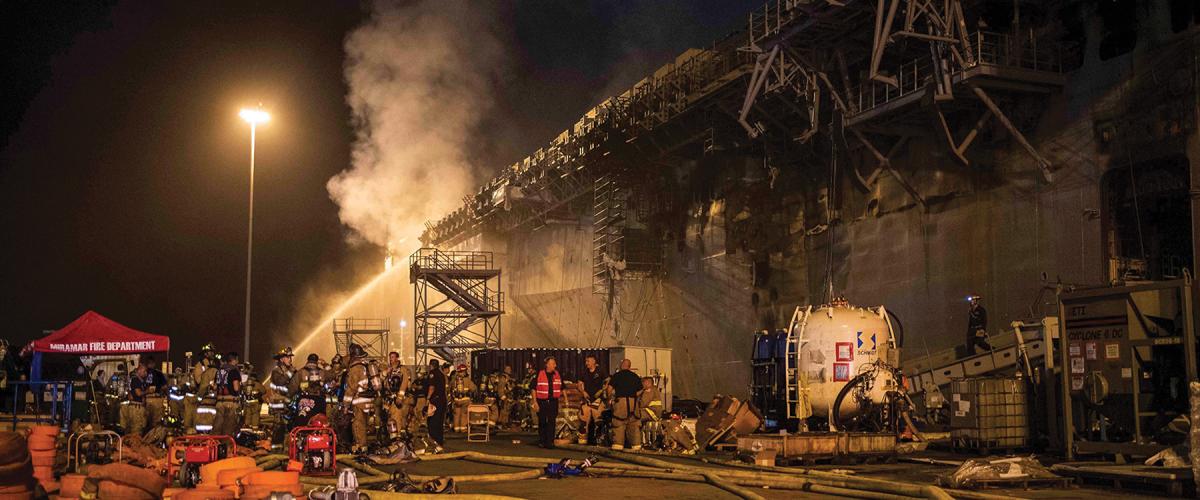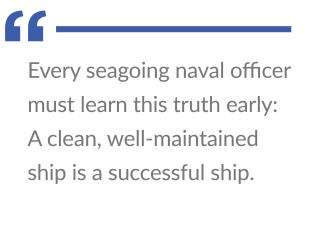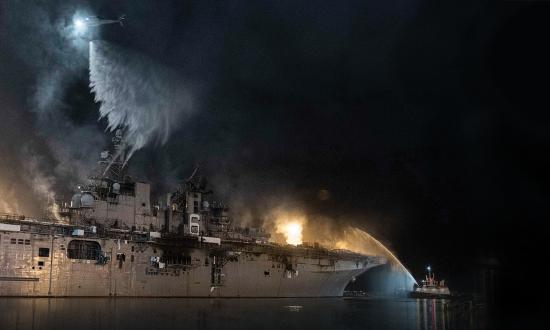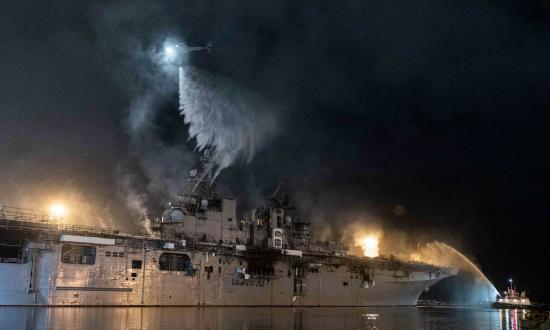I read of the loss by fire of the USS Bonhomme Richard (LHD-6) with dismay. The ship was undergoing a depot-level availability pierside in San Diego, California. Ships are particularly vulnerable to fire and flooding during such periods because watertight integrity and fire boundaries are compromised to support depot-level work. Flammable materials can find their way on board in quantity, and ships easily become very dirty. Shipboard firefighting and damage control equipment are shut down and tagged out.
These hazards can be mitigated only by the vigilance and actions of those who “own” the ship: the crew. Failure of vigilance and response can lead to disaster, as happened to the Bonhomme Richard.
Root Causes
There were a number of internal and external factors that contributed to the loss of the Bonhomme Richard. However, the root causes cited in the command investigation fall squarely on ship’s force:
Material Condition. Throughout the maintenance period, the material condition of the ship was significantly degraded, including heat-detection capability, communication equipment, shipboard firefighting systems, miscellaneous gear clutter, and combustible material accumulation. On the morning of the fire, 87 percent of the ship’s fire stations were in inactive equipment maintenance status.
Training and Readiness. The training and readiness of ship’s force was marked by failed drills, minimal crew participation, lack of basic knowledge on firefighting in an industrial environment, and unfamiliarity with how to integrate supporting civilian firefighters. The crew had failed to meet the time standard for applying firefighting agent on the seat of a fire on 14 consecutive occasions leading up to the 12 July 2020 fire.1
Poor Housekeeping. Every seagoing naval officer must learn this truth early: A clean, well-maintained ship is a successful ship. Cleanliness and good maintenance are a reflection of a crew dedicated to excellence in their ship’s operations and material condition. Unfortunately, the converse is also often true, as Vice Admiral Scott Conn’s investigation led him to conclude was the case with the Bonhomme Richard. Bureau of Alcohol, Tobacco, Firearms, and Explosives (ATF) investigators assessed that the fire was caused by arson:
ATF conducted a systematic fire scene examination and determined the fire originated in Lower Vehicle Stowage Area (Lower V). . . . ATF determined that once the fire ignited, it spread to the significant amount of combustible material stored within Lower V, which included dozens of tri-walls filled with gear and equipment and three fueled vehicles (a forklift, a man-lift, and a cargo tractor).2
Regardless of what initiated the fire, however, its spread was facilitated by poor housekeeping in a remote compartment that clearly was not regularly visited or inspected.
To minimize the risk of such a fire, all naval vessels should have one or more roving watches whose job it is to visit all shipboard spaces and report problems such as developing damage control emergencies. Division officers should inspect their spaces daily for cleanliness and accumulation of fire hazards. The damage control assistant should walk the ship below the damage control deck daily, ensuring no fire or flooding hazards are present. That none of these measures appear to have been taken left vulnerable spaces unattended and permitted the accumulation of fire hazards.
Firefighting Deficiencies. Commander Joel Holwitt and Captain Mary K. Hays’ article “Every Sailor a Firefighter” in the August 2022 Proceedings is excellent in identifying deficiencies in and offering a solution to shipboard in-port firefighting training and execution.3 The article also reads much like Naval Ships’ Technical Manual (NSTM) chapter 555, “Surface Ship Firefighting.” In other words, what Holwitt and Hays propose is nothing new. The procedures they offer have been an integral part of shipboard in-port and at-sea damage control for years.
Twenty years ago, when I was in command of a frigate, every sailor reporting to a Navy ship was required to complete the Basic Damage Control qualification within a prescribed time frame. In addition, the new sailor had to complete the two-day Basic Shipboard Firefighting course. Only when these requirements were met could he or she be assigned to a duty section in-port emergency team. Timely completion of these qualifications was essential to permit the ship to man four complete fire parties in homeport to sustain a reasonable four-section duty rotation.
Continual training, including daily drills, was essential to create and sustain effective teams that could act as first responders to fires and other damage control emergencies. In-port readiness was considered so important that the command duty officer was expected to observe and evaluate the drills conducted by his duty section. Further, certification of in-port fire parties by the Afloat Training Group and Propulsion Examining Board were prerequisites to successful completion of basic predeployment training.
This level of training clearly was not occurring in the Bonhomme Richard. This can be explained in part by the high crew turnover that occurs during an extended depot-level availability. Experienced sailors depart and are replaced by inexperienced ones. Higher priorities often lead to postponement of required training until the predeployment training cycle looms near the end of the yard period. However, given that it is during the availability that the ship is most vulnerable to any number of casualties (fire, flooding, toxic gas, etc), failure to provide adequate damage control capability greatly increases the risk of catastrophic damage. Lack of operational risk management aggravates the problem.
What’s Gone Wrong?
The Navy has promoted a culture that deprives junior officers of the opportunity to exercise meaningful responsibility and real accountability for sailors, equipment, and compartments. Instead, they are encouraged to focus on personal career development. For example, Lieutenant Commander Emma McCarthy writes in the October 2022 Proceedings:
The submarine force devalues the experience of shipyard junior officers whose mission has been returning warships to fighting shape. These junior officers spend their days in shipyards laboring over work controls and complex maintenance procedures to the detriment of their navigation and tactical prowess. They are at a disadvantage because they spend less time at sea honing their skills on the tip of the Navy’s lethal spear.4
I have a number of reservations about this statement. First, only a small portion of time at sea is spent honing lethal, tip-of-the-spear skills. Many more hours
are spent standing watch, honing seamanship and navigation skills or propulsion plant operations skills. This is important, but experience has shown there will be time enough for this essential training when the ship or boat comes out of the shipyard.
Second, the leadership experience a junior officer gains in a shipyard can be invaluable. Leadership in port is in many respects more challenging than at sea. The distractions of home and family life are more immediately present in a sailor’s life, as are other distractions that can lead to destructive behaviors such as alcoholism and drug abuse. In the face of such challenges, it is up to division officers to inspire high morale among their sailors, by enforcing high standards of performance while providing opportunities for personal and professional development. Enforcing high standards requires division officers’ untiring vigilance and recognition that they bear responsibility for their sailors 24 hours a day, 7 days a week. Learning to live up to this responsibility is infinitely more important in preparing for command than earning a gold qualification pin.
If the Navy deprives junior officers of challenging leadership opportunities such as leading a division during a long-duration shipyard availability, it deprives its ships of intelligent officers who can meet the high standards of leader accountability. It also conveys the message to junior officers that their own professional development is more important than leading their divisions.
Officers should embrace the idea that it is their responsibility to accomplish the mission and bring the crew home safe. The mission spans operations at the tip of the spear to an extended shipyard availability. An officer brings the crew home safe by ensuring that every sailor, regardless of the mission, leaves the ship to return to his or her family, intact in body and mind. Fostering this attitude in Navy culture may go a long way to preventing a catastrophe such as that which befell the Bonhomme Richard.
1. VADM Scott D. Conn, USN, memo N00/156 dtd 5 Apr 21, “Command Investigation into the Circumstances Surrounding the Fire Onboard USS Bonhomme Richard (LHD-6) on or about 12 July 2020.”
2. Conn, “Command Investigation,” 21. The sailor charged by the Navy with starting the fire was acquitted of all charges on 30 September 2022. See Gidget Fuentes, “UPDATED: Former Bonhomme Richard Sailor Ryan Sawyer Mays Acquitted of Arson,” USNI News, 30 September 2022, “Defense attorneys had argued that there was more than enough reasonable doubt in the Navy’s prosecution to find him not guilty of the charges. They said he’s consistently pressed his innocence and questioned whether it was arson that started the blaze or just an accidental fire sparked by faulty vehicles or lithium-ion batteries that were stored in the area, which sailors and contractors working on the ship had used as a junkyard.”
3. CDR Joel I. Holwitt and CAPT Mary K. Hays, USN, “Every Sailor a Firefighter,” U.S. Naval Institute Proceedings 148, no. 8 (August 2022).
4. LCDR Emma McCarthy, USN, “Take JOs Out of the Shipyards,” U.S. Naval Institute Proceedings 148, no. 10 (October 2022).







